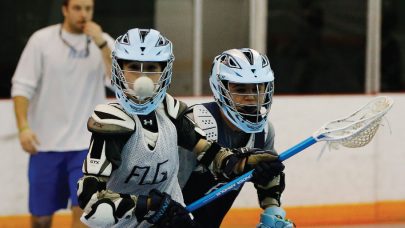FLG’s annual box lacrosse training program is rapidly approaching. In the box rinks on Long Island we look to replicate Canadian box lacrosse drills, techniques, and style of play. I was talking to a parent who has two kids coming to our box lacrosse training this winter. In conversation he asked me, “do the you teach player’s to use their opposite hands in the box rink?” After pondering how to answer that questions, I soon realized that’s a pretty loaded question. It had me wonder:
What should be our philosophy on using opposites hands in the rink?
Is there time to teach everything we do with the strong hand with the weak hand?
Is the box rink a good time to work on your opposite hand?
Why do Canadians typically play with 1 hand?
Below was my response:
In the box rink, we teach a variety of passing variations and shooting techniques. This includes, leaners, wristers, shovel passes, levers, behind-the-backs, one-handers, and much more. Some of these passing and shooting variations may be completely foreign to even some of the most advanced youth lacrosse players here on Long Island. Being that player’s are learning new technique for the first time, it takes time to develop these skills effectively even with their strong hand. Secondly, in the box rink, you are playing in tighter spaces. When you play in tight spaces, you have to make decisions, move the ball, and play that much faster. When you play faster, typically you don’t have time to switch hands. This takes time. The longer you take, the less effective you are in the rink. That being said, the box rink usually isn’t a time for players to work on their opposite hand. It’s a time to try new things with their strong hands. Develop in tight spacing using the skills and techniques taught with their strong hand. Get that much better at finishing the rock in tight with their strong hand. Now, there are always exceptions. Players who have experience playing that box-field hybrid game might want to develop new skills with their opposite hand. We will never prevent someone from trying new things with their opposite hands in the box rink.
Long story short, it depends on the level of the players, the age, the experience, and the situation whether or not we have player’s work on that weak hand.


Great article, nice insight.
Thanks, Sean! Glad you enjoyed reading it!